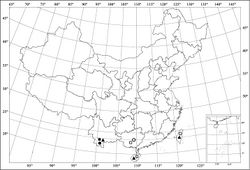Aspidimerus menglensis
| Notice: | This page is derived from the original publication listed below, whose author(s) should always be credited. Further contributors may edit and improve the content of this page and, consequently, need to be credited as well (see page history). Any assessment of factual correctness requires a careful review of the original article as well as of subsequent contributions.
If you are uncertain whether your planned contribution is correct or not, we suggest that you use the associated discussion page instead of editing the page directly. This page should be cited as follows (rationale):
Citation formats to copy and paste
BibTeX: @article{Huo2013ZooKeys348, RIS/ Endnote: TY - JOUR Wikipedia/ Citizendium: <ref name="Huo2013ZooKeys348">{{Citation See also the citation download page at the journal. |
Ordo: Coleoptera
Familia: Coccinellidae
Genus: Aspidimerus
Name
Aspidimerus menglensis Huo & Ren sp. n. – Wikispecies link – ZooBank link – Pensoft Profile
Diagnosis
This species is similar to Aspidimerus birmanicus (Gorham) in general appearance, but can be identified by the characters as follows: penis guide moderately broad, symmetrical, almost parallel-sided with arcuate apex in ventral view, distinctly shorter than parameres (Fig. 50), while in Aspidimerus birmanicus (Gorham) penis guide narrow, slightly expanded in the middle and narrower towards the apex which is truncate.
It is also similar to Aspidimerus guangxiensis in color pattern (Figs 18, 24), but can be distinguished from the latter by its larger size and male genitalia.
Description
TL: 3.50–3.90mm, TW: 2.65–3.15mm, TH: 1.50–1.75mm, TL/TW: 1.24–1.32; PL/PW: 0.51–0.55; EL/EW: 1.02–1.13.
Body oval, dorsum moderately convex and pubescent (Figs 18–20). Head yellow with the base brown in male and black in female. Clypeus reddish brown. Eyes black. Pronotum black except anterior corner yellow (Fig. 20). Scutellum black. Elytra black with two round yellow spots (Fig. 18). Underside black, except mesoventrite and legs brown.
Head small, 0.47 times elytral width (HW/EW=1:2.12). Punctures on frons fine, separated by 0.2–0.5 times their diameter, with thick, golden pubescence. Eyes large and almost oval, rather finely faceted, the widest interocular distance 0.36 times head width. Pronotum 0.72 times elytral width (PW/EW=1:1.39), closely covered with small punctures and golden pubescence, denser than those on head, punctures separated by 0.5–1.0 times their diameter. Punctures on elytra very fine and close, separated by 0.5–1.5 times their diameter, with short silver white pubescence. Prosternum with sparse, coarse punctation and long pubescence. Mesoventrite small, with inconspicuous punctures and sparse pubescence. Metaventrite finely punctate, separated by 0.2–1.0 times their diameter, with pubescence dense, short and silver white.
Male genitalia: Penis long, strongly curved. Penis capsule with a short outer process and a long inner one (Fig. 48). Apex of penis with membranous appendage (Fig. 49). Penis guide slender in lateral view (Fig. 51). In ventral view, penis guide symmetrical, almost parallel-sided with arcuate apex (Fig. 50); Parameres slender, longer than penis guide, with dense long setation at its apex and inner side (Fig. 50).
Female genitalia: Tenth tergite fairly broad, 0.25 times as long as wide, with moderately long setae. Coxites subtriangular, each with a few long terminal setae (Fig. 52).
Types
Holotype: 1♂, China, Yunnan: Mengla, Xishuangbanna, [21°26.59'N, 101°38.01'E], ca 1160 m, 29.iv.2008, Wang XM leg. (SCAU). Paratypes (3): Yunnan: 1♂, Nanping, Mengla, [21°39.55'N, 101°22.52'E], ca 750m, 10.v.2009, Ren SX leg. (SCAU); 1♀, Mengla, Xishuangbanna, [21°26.59'N, 101°38.01'E], ca 1160m, 29.iv.2008, Wang XM leg. (SCAU); 1♂, Longmen, Mengla, [21°30.17'N, 101°31.44'E], ca 760m, 1.v.2008, Wang XM leg. (SCAU).
Distribution
China (Yunnan).
Etymology
The specific epithet refers to the type locality, Mengla, Yunnan.
Original Description
- Huo, L; Wang, X; Chen, X; Ren, S; 2013: The genus Aspidimerus Mulsant, 1850 (Coleoptera, Coccinellidae) from China, with descriptions of two new species ZooKeys, 348: 47-75. doi
Images
|



